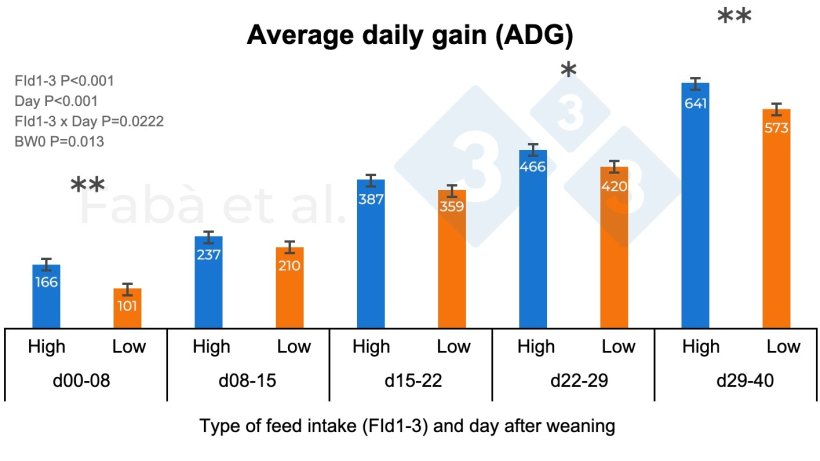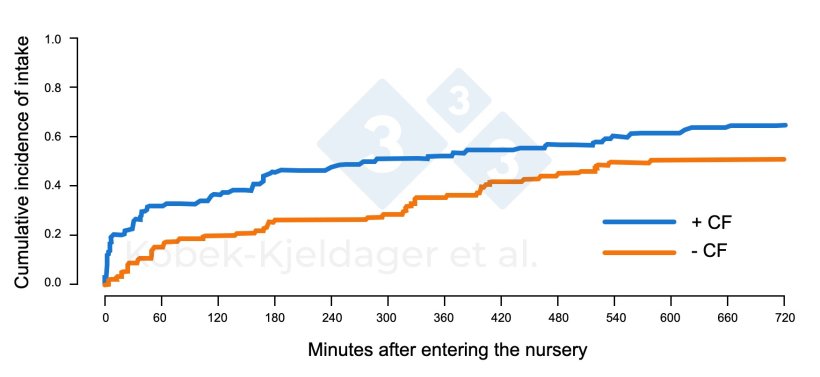Optimizing feed presentation involves introducing improvements in formulation and manufacturing processes, with the aim of maximizing production performance, improving feed efficiency, and minimizing both waste and costs, without losing sight of animal welfare. This optimization encompasses all stages, from initial formulation and production at the feed mill to the evaluation of the final product— the meat—seeking to maximize the efficiency and welfare of pig production.
In the nursery, post-weaning phase
During the first days post-weaning, it is essential to encourage pigs to eat while offering feed that is safe for digestion.

A recent study has shown that piglets that consume more during the first three days post-weaning (626 vs. 311 g/d) grow more (400 vs. 351 g/d), have greater gastrointestinal development, and lower protein fermentation on day 6 post-weaning (Fabà et al., 2024, Figure 1).

One strategy to encourage piglets' consumption after weaning is to offer feed during lactation, known as creep feed (Kobek-kjeldager et al., 2021, Figure 2).

However, recent unpublished data from our research group has observed that, in a batch of 624 piglets weaned at 21 days of age under commercial conditions, only 4.5% of the piglets consumed creep feed continuously during lactation and the first 4 days post-weaning (consumers). Meanwhile, 26% of the piglets did not consume creep feed at any time (non-consumers). The impact of consumption levels on the growth results of these piglets was direct.
The consumer piglets had an average growth rate of 117 g/d during the first 10 days post-weaning, while the non-consumer piglets grew just 27 g/d (P < 0.001). The remaining 69.5% of piglets, i.e., piglets that did not consume feed during lactation but did during the first 4 days post-weaning, achieved an intermediate growth rate of 72.8 g/d.
In line with these results, Kuller et al. (2007) concluded that creep feed intake during lactation has a positive influence on productive performance and nutrient absorption capacity post-weaning (Kuller et al., 2007). Additionally, it has been observed that piglets that do not consume feed upon arrival at the nursery facilities show compensatory overconsumption, which increases the risk of digestive problems (Lallès et al., 2004; Laine et al., 2008).
The question is: What can we do to increase piglets' intake after weaning? Factors such as age, gastrointestinal health, piglet origin (born from primiparous or multiparous sows), and environmental conditions influence the decision of nutritional and management strategy for piglets during lactation and the nursery phase. In this regard, Kobek-kjeldager et al. (2021) observed a higher cumulative incidence of intake throughout the nursery period in piglets weaned at 35 days of age compared to piglets weaned at 24 days of age. Therefore, if in the aforementioned unpublished study by our group, the piglets were around 35 days old at the time of weaning, the percentage of consumers would surely have been higher.
Therefore, management has a major impact on the piglets' start of weaning, but, focusing on the issue at hand, what are we trying to achieve in the first few days post-weaning in terms of gastrointestinal health by introducing feed?…
In post-weaning, one of the physiological limitations of piglets is poor secretion of hydrochloric acid, which is essential for protein digestion. This, combined with large meals, makes it difficult to achieve a gastric pH of between 2 and 3, leading to a high risk that the protein will reach the intestine undigested, providing a substrate for the growth of pathogenic bacteria and, consequently, leading to digestive problems. Therefore, in terms of feed formulation, we look for ingredients that provide nutrients, but also functionality, with the aim of:
- increasing gastric retention time to facilitate protein hydrolysis,
- increasing contact between food and enzymes, and
- reducing the fermentation of undigested protein in the intestine.
To achieve this, we can consider several factors related to the presentation of the feed:
- Viscosity
- Particle size and distribution
- Hardness and durability of the granules
These are the topics we will cover in the second part of this article, “Optimizing feed presentation during nursery phases (II).”




